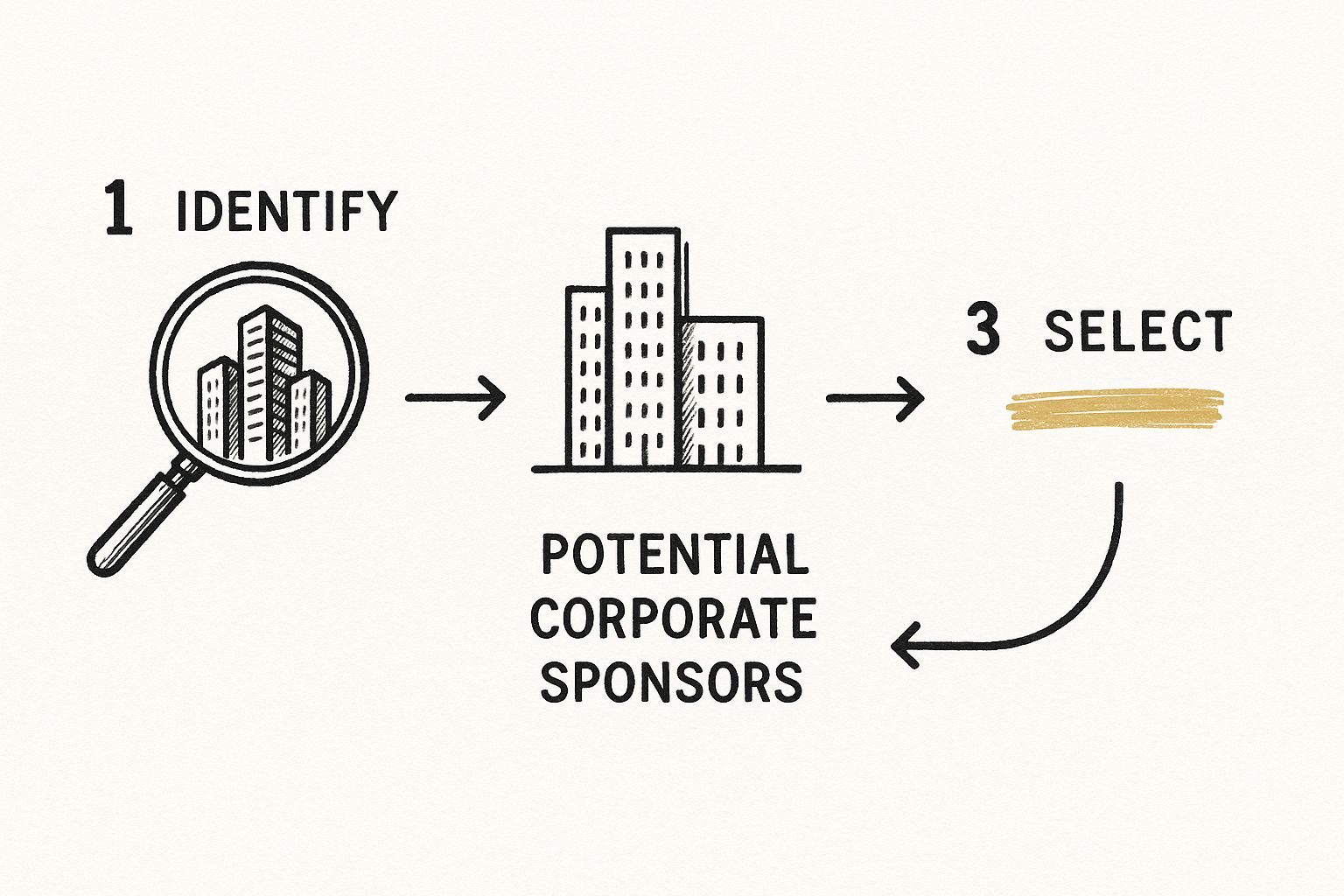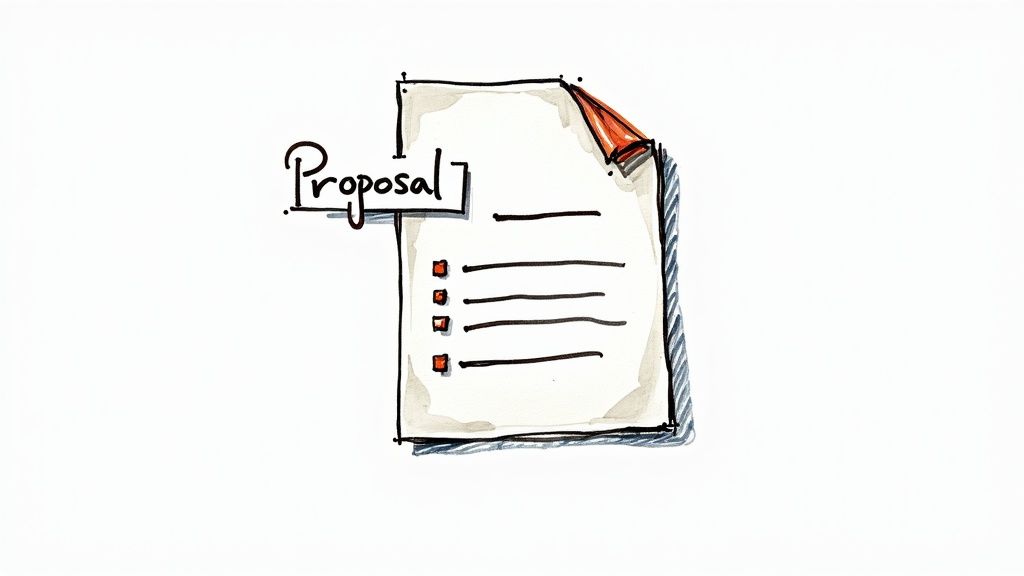August 12, 2025

To land a corporate sponsorship, you have to completely change your mindset. Stop thinking about it as asking for money and start thinking about it as offering a solution. It's about showing a brand that partnering with you creates clear, mutual value. The whole game is about defining what you can offer, finding companies that need exactly that, and building a proposal that solves their problems.
Before you even think about sending an email or making a call, you need to do the heavy lifting upfront. This is where most people get it wrong. They focus on what they need, but you need to become obsessed with what a corporate partner gets out of the deal. This entire stage is about building a rock-solid case for your value.
It all begins with what makes you unique. Forget vanity metrics for a moment and focus on the tangible assets you bring to the table. Who, exactly, is the audience you can deliver to a sponsor? How big is your reach? More importantly, how connected and engaged is that community?
The most powerful thing you can offer a sponsor is the chance to show their generosity to their audience, not just yours. Frame your benefits this way, and you start speaking their language. It shows you genuinely get what they're trying to achieve with their marketing.
Put yourself in the shoes of a brand manager. They aren't running a charity; they're investing a marketing budget and need to see a return on that investment. Your job is to make that return crystal clear.
Before you jump into outreach, it’s a good idea to take stock of what you have. This quick checklist will help you make sure all your essential pieces are in place, turning a potential "no" into a confident "yes."
Use this checklist to confirm you have the essential elements in place before you begin outreach to potential corporate sponsors.
Having these items checked off doesn’t just make you look more professional—it gives you the confidence to approach sponsors as an equal partner, not as someone asking for a handout.
Your prospect list shouldn't be a random spray-and-pray of Fortune 500 companies. It needs to be a strategically curated list. The best way to do this is to become a detective. Look at a company’s recent activities, like their past sponsorships, their current marketing campaigns, and any public statements about their corporate values.
This is more important now than ever. Global sponsorship trends show a massive shift toward partnerships that demonstrate social impact and a commitment to DEIB (diversity, equity, inclusion, and belonging). Brands are actively looking for ways to prove they care about Environmental, Social, and Governance (ESG) criteria. If you can show how your project aligns with these goals, you immediately gain a powerful advantage. You can dive deeper into these changes by exploring the latest global sponsorship trends report.
When you truly understand what a company cares about, your pitch is no longer a cold ask. It becomes a compelling, strategic opportunity they’d be foolish to ignore. This kind of thoughtful prep work is what separates the amateur requests from the professional proposals that actually get funded.
A great partnership all comes down to finding the perfect fit. I’ve seen countless people waste months chasing the wrong sponsors, and it’s a painful lesson. A mismatched collaboration doesn't help anyone. The secret to landing corporate sponsorships isn’t casting a wider net—it's about building a highly targeted list of ideal partners from the very beginning.
So, where do you start? Put on your strategist hat for a moment. Think about who is already spending money in your niche. Look at events, organizations, or even other creators similar to you and see which brands are backing them. The goal here isn't to steal their sponsors, but to identify companies that already see the value in an audience like yours.
This process moves you from a wide-open search to a shortlist of genuinely qualified prospects.

As the visual shows, it's a methodical approach. You're filtering companies based on how well they align with your goals and, crucially, whether you can actually reach the person who makes the decisions.
Once you have a list of potential companies, the real detective work begins. For each one, you need to dig deep into their marketing goals, their target audience, and their overall brand values. Are they about to launch a new product that your audience would love? Did they just announce a big push into community work that perfectly aligns with your mission?
A company’s annual report or their recent press releases are absolute goldmines. They literally spell out the company's priorities for the year, giving you the exact language and goals you can reflect back in your proposal.
Pinpointing these ideal corporate partners is a critical first step. You can sharpen your process by exploring some proven B2B sales lead generation strategies to find companies that are a true match.
Look, your amazing proposal is completely worthless if it lands on the wrong person's desk. And I’ll give you a hint: it’s almost never the CEO. You need to find the person whose job performance is measured by the exact kind of results your partnership can deliver.
Think about titles like:
LinkedIn is your best friend here. Search for these job titles within your target companies. It's also worth remembering that 77% of consumers are more likely to buy from brands with strong corporate social responsibility programs—a huge motivator for people in these roles. This focused approach is what gets your proposal seriously considered and dramatically boosts your chances of getting a response.
For a deeper dive into this part of the process, our guide on how to get sponsors has even more tips.

Let's be honest: your sponsorship proposal is your make-or-break sales pitch. Sending out a generic, cookie-cutter document is the fastest way to get your email deleted. To actually capture a brand's attention, you need to build a compelling, tailored proposal that speaks directly to their business goals.
This isn't just about asking for money. It's about showing them how a partnership with you solves one of their problems. Frame the entire conversation around what they get—whether that’s reaching a niche audience they can't access, boosting their brand reputation, or getting their product into the hands of new customers.
Think of the executive summary as your one-page elevator pitch. It’s often the only part a busy executive will read at first, so it has to be sharp, concise, and incredibly persuasive. It needs to immediately answer their unspoken question: “What’s in it for us?”
Don’t waste time with a long history of your organization. Lead with the opportunity you're presenting. In just a few sentences, summarize the partnership, outline the key benefits for the sponsor, and state the investment you're asking for. This is the trailer to your movie—make them want to stick around for the feature film.
Your executive summary has to communicate the core value proposition in under 30 seconds. If a marketing manager can't grasp the benefit by the end of that first page, you've lost them.
This is where you swap vague promises for cold, hard data. Don't just claim you have an “engaged audience”—prove it. Nothing is more persuasive than a crystal-clear picture of the people you can connect them with.
Painting this detailed picture helps a sponsor see their ideal customer within your community. Suddenly, the partnership feels less like a gamble and more like a smart, strategic move. Remember, the global sponsorship rights market, valued at USD 31.4 billion, is built on finding these perfect alignments.
Never, ever present a single, take-it-or-leave-it price. Giving a potential sponsor options gives them a sense of control and dramatically increases your odds of finding a common ground. I always recommend creating tiered packages—think Platinum, Gold, and Silver—that offer distinct, escalating benefits.
Here’s a simple way to structure it:
Each level should provide a clear step-up in value that justifies the higher cost. This structure makes it easy for companies with different budgets to find a way to get involved. If you need more inspiration, check out different winning bid proposal formats to see how successful deals are structured.
Ultimately, a great proposal makes it easy for a sponsor to say "yes" by clearly showing them their return on investment through tangible outcomes like brand lift, media exposure, and genuine leads.
https://www.youtube.com/embed/fFzJ-cq5VOg
So, you got a "yes" on your sponsorship proposal. That's a huge milestone, but don't pop the champagne just yet. In my experience, this isn't the finish line—it's actually the starting gun for the real back-and-forth. This is where you turn their interest into a signed, sealed, and delivered formal agreement.
The key to handling this phase is to walk in with confidence and a spirit of collaboration. I've learned to think of it less like a battle and more like a creative session where we're building the best possible partnership together. Your job is to keep reinforcing the value you both get, setting the stage for a relationship that lasts.
Before you ever hop on that call, you need to be over-prepared. This is absolutely not the time to wing it. I always reread my original proposal, putting myself in their shoes and trying to predict what questions or pushback they might have.
When the call starts, set a collaborative tone from the first sentence. Instead of launching into your asks, lead with your excitement about working together and briefly touch on the core value for them.
"We're really excited about the potential here. We know you're looking to connect with young professionals in the tech space, and we see a great way to genuinely integrate your brand into our community."
This little shift frames the entire conversation around their success, not just your needs. It instantly shows you’ve been listening and are focused on their results. You’re not just trying to get a check; you're starting a business relationship.
Let's be real: it's incredibly rare for a sponsor to accept the first offer without a single question. Expect to hear things like, "That's a bit higher than we budgeted," or "Can we swap this benefit for that one?" Don't panic or get defensive. These are actually good signs—they’re buying signals, not rejections.
Here’s a simple framework I use when I get pushback:
Knowing where you can bend is the art of negotiation. The goal isn't to "win" every point; it's to find that sweet spot where everyone feels like they got a great deal.
Once you’ve shaken hands (even virtually) on the terms, it's time to get it all down in writing. This formal sponsorship agreement is your safety net. It protects both you and the sponsor and makes sure there are no "I thought you meant..." moments later on.
A rock-solid agreement needs to spell out every single detail. Make sure yours covers:
When you handle these final conversations with a focus on partnership, you do more than just lock in a sponsor. You build the foundation for a strong alliance that can grow and pay dividends for years to come.
Getting that signature on the sponsorship agreement feels like a huge win—and it is! But think of it as the starting line, not the finish. The activation phase is where the promises you made on paper come to life. This is where you build the foundation for a long-term, renewable partnership.
A successful corporate sponsorship comes down to delivering on every single promise, and then looking for opportunities to over-deliver. I've seen far too many great-on-paper partnerships fall apart simply because of sloppy execution. The shift from selling the dream to actually building it is everything.
The very first thing I do after an agreement is signed is create a detailed activation calendar. I mean detailed. Every social media post, every email mention, every logo placement, every on-site deliverable gets mapped out with a firm deadline. This isn't just for my team; it's a shared roadmap that keeps us and the sponsor perfectly in sync.
A fantastic partnership is a two-way street, a constant conversation. Don't ever make your sponsors chase you for updates. Proactive communication is your best friend here; it builds incredible trust and shows you’re a true professional.
Here are a few things that have always worked for me:
This kind of proactive management shows them you see them as a genuine partner in your success, not just a checkbook. When you've built well-defined event sponsorship packages from the start, this whole process becomes much easier because the expectations are already crystal clear.
After the dust settles, your final job is to prove you delivered a real return on their investment (ROI). This is where a comprehensive fulfillment report becomes your most powerful tool for securing a renewal. Don’t just send a checklist of things you did. This report needs to tell the full story of the partnership's success.
Your fulfillment report should make the renewal conversation feel like the obvious and natural next step. It’s your final pitch, proving the immense value you delivered and turning a one-time deal into a lasting alliance.
Pack it with hard numbers: social media reach, website traffic driven, leads generated, and attendee engagement data. But don't stop there. Marry that quantitative data with qualitative proof, like powerful attendee testimonials and vibrant photos of their brand connecting with your audience. Your skill in measuring event success is what will ultimately convince them to sign on for another year.
This focus on provable ROI is more critical than ever. The sports sponsorship market alone was valued at USD 60.17 billion globally and is expected to rocket to USD 132.86 billion by 2033, all because of the massive brand exposure these deals generate. When you can back up your results with solid data, you're not just another option; you become a can't-miss opportunity in a very crowded field. For a deeper dive, check out more on the growth of the sports sponsorship market.

When you're new to the sponsorship game, it's natural to have a lot of questions. In my experience, a few key uncertainties tend to trip people up more than others. Let’s walk through the big ones so you can move forward with a clear, confident plan.
This is the million-dollar question, isn't it? The biggest mistake I see is people pulling a number out of thin air. A much stronger approach is to build your pricing based on the real, tangible value you’re offering.
Start by breaking down every single benefit you can provide and assigning it a fair market value. For instance, what’s a sponsored post on your social media channels actually worth? How about a dedicated email blast to your list? Once you've priced out each individual asset, you can bundle them into compelling, tiered packages. This isn't just about justifying your price; it shows a potential sponsor you're a strategic, buttoned-up partner, not an amateur.
Key Takeaway: Rejection is just part of the process. A "no" today isn't a "no" forever. Responding graciously can leave the door wide open for future opportunities when the timing or budget aligns.
No insider connection? No problem. This is where a little digital detective work comes in handy. Your best bet is almost always LinkedIn.
Forget about trying to reach the CEO. You need to find the person whose job it is to say "yes." Look for titles like Brand Manager, Marketing Manager, or Community Relations Director, often for the specific region or product line you're targeting.
Before you even think about hitting "connect," do your homework. Engage with their posts, see what they're talking about, and look for a genuine point of connection. A personalized message referencing a recent company win or a shared professional interest will get you so much further than a generic cold email ever will.
First off, don't sweat it. It happens to everyone. The absolute worst thing you can do is take it personally or get defensive.
Instead, reply with a gracious and professional thank-you note. Acknowledge their time and consideration. If the conversation felt positive, it's perfectly acceptable to politely ask if they'd be open to sharing any specific feedback on why it wasn't the right fit.
Those insights are pure gold and will help you strengthen every proposal you send afterward. This keeps the relationship positive and ensures you stay on their radar. Remember, learning how to get sponsorship is a long game, and every interaction is a chance to build a bridge for the future.
Ready to manage those new partnerships like a pro? GroupOS provides an all-in-one platform to showcase sponsors, manage events, and grow your community. Discover how GroupOS can help you deliver incredible value to your corporate partners.


